Brooder heat lamps are terrifyingly dangerous. Every year, news stories recount tales of human and animal deaths and homes and chicken coops burning down as a result of a heat lamp fire. Whether from falling, being knocked over, swinging into contact with a flammable object, dust on the bulb igniting, or a bird or loose feather flying up into it, the traditional heat lamp is a fire hazard even when carefully used.
Regardless of how carefully it is hung or how many different ways it is tethered, I never got past that gnawing feeling that something beyond my control could result in catastrophe and my instincts were correct. The simple truth is: heat lamps cannot be made fool-proof with flying animals.
The fire in the photo below resulted from a heat lamp that fell. There were 2 goats, 3 goslings, 3 ducklings and approximately 13 chicks in the area of the heat lamp who would have perished if the chicken-keeper hadn’t come upon the scene when she did.

Heat lamp reflectors, ordinarily made of aluminum, commonly include a hanger and a clamp. The problem with the design is that there are several points at which its parts can fail. I never use heat lamps and strongly recommend chicken keepers never use them either.


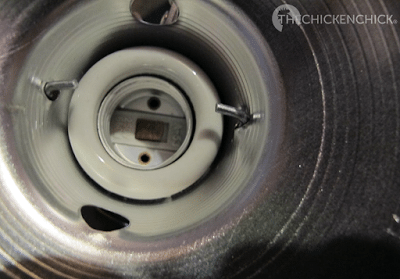

Meet the original baby chick warmer: the mother hen.

Observing mother hens interact with their babies in my backyard has completely convinced me that baby chicks do not need as much heat as we are led to believe.
Newly hatched chicks cannot regulate their own body temperatures, which is why a hen keeps her chicks underneath her warm abdomen after hatching. As time passes, they spend much less time underneath her, dashing in and out of their 90°F maternal feather-bed, each regulating its own comfort level.
We are all taught “The Formula” for brooding baby chicks under a heat lamp: 90-95° F for the first week of life, decreasing by five degrees each week thereafter, but the formula doesn’t work for backyard chicks; it calls for far too much heat in a small space for far longer than chicks require, allowing no deviation for individual chicks’ comfort levels. Learn more about how much heat chicks really need, HERE.
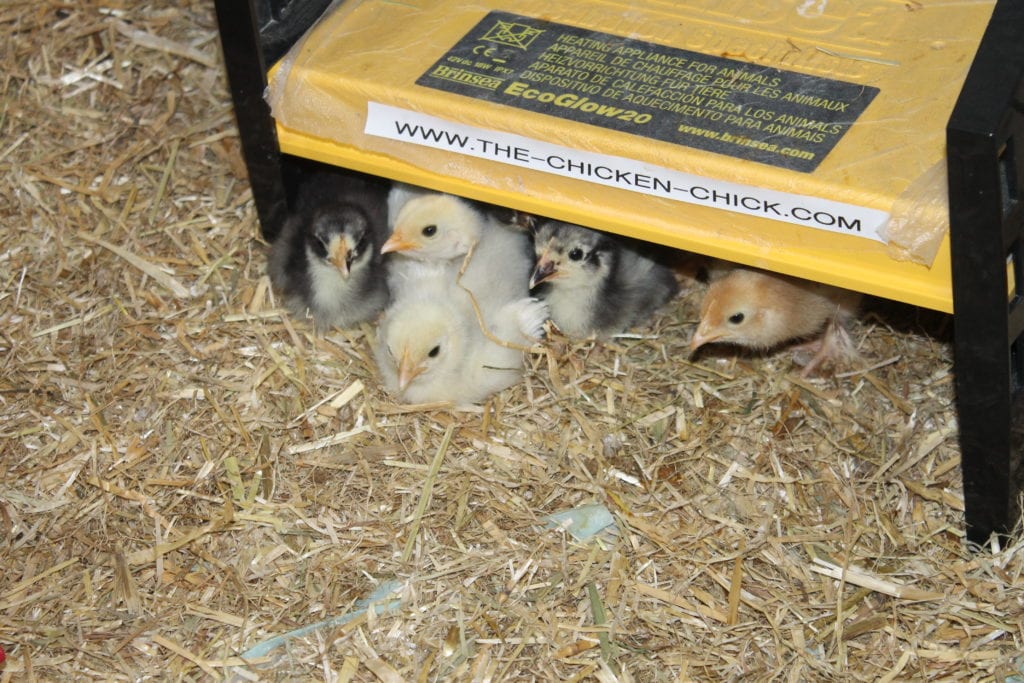
Brinsea Products offers the EcoGlow Brooder, which employs the same warming concept as a mother hen. Just as with a hen, chicks spend much of their time underneath the EcoGlow for the first few days after hatching. They peek out from underneath it occasionally, gradually spending more and more time away from it. They run around eating, drinking, returning to the EcoGlow when they need a warm-up. Before too long, and much sooner than you’d expect, they spend most of their time away from the EcoGlow brooder. The EcoGlow brooder plate does not warm up the entire brooder, it warms only the chicks underneath it, allowing them to regulate their own comfort level by where they are in the brooder- just as with a mother hen!

In my experience the Advantages of the EcoGlow over a heat lamp are:
- it’s more like mama hen, chicks snuggle up underneath the brooder plate only when they feel it necessary
- no fire hazard as with heat lamps
- no overheating of chicks, reducing the likelihood of stress-induced aggression and picking
- uses less electricity (14 watts vs. 250 watts with a heat lamp)
- no risk of pasty butt from overheating
- no disruptive light, allowing chicks to sleep at night as they should
- height is easily adjusted for growing chicks
- no fussy machinations required to hang the heat source, making brooder location more flexible

The EcoGlow operates on the principle of radiant heat, which passes through air without warming the air. Only a solid object will absorb and be warmed by radiant heat, so do not expect to put your hand underneath it briefly and be able to gauge whether or not it is working. A thermometer won’t help either since it will only measure the air temperature, not how well the radiant heat is working to keep chicks warm. The underside of the EcoGlow should feel barely warm to the touch.
IMPORTANT NOTE: Baby chicks must be brooded in an area with an ambient temperature of at least 50°F!
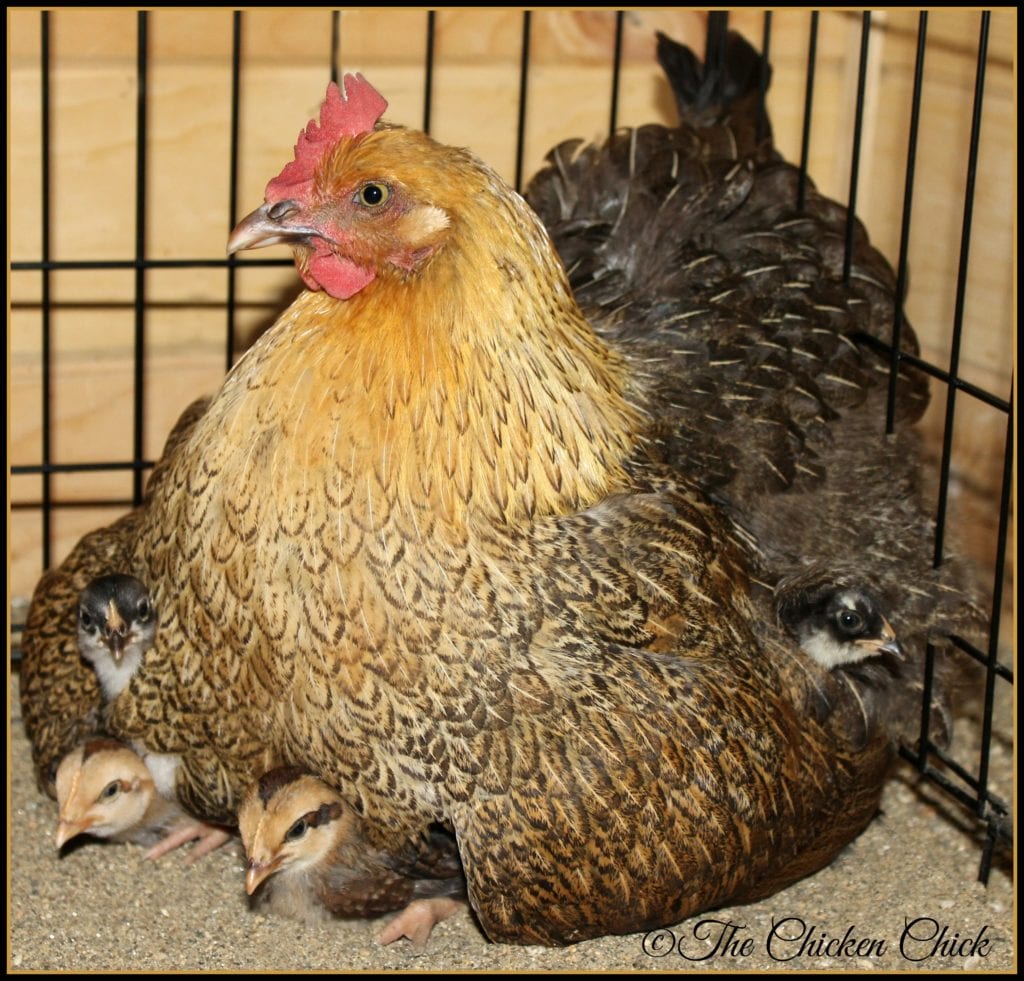

CLEANING TIP: As soon as chicks realize they can hop up on top of the EcoGlow, they spend much of their time standing on and pooping on it. While cleaning the EcoGlow is straightforward, I never relish the idea of scraping chicken poop off the top of it when the chicks are finished with it. In order to make my life easier, I cut a piece of Glad Press-n-Seal to fit the top of the EcoGlow, which makes cleaning a BREEZE! (Con-tact paper was my former product of choice, but Press-n-Seal is much easier to remove.)

Kathy Shea Mormino
Affectionately known internationally as The Chicken Chick®, Kathy Shea Mormino shares a fun-loving, informative style to raising backyard chickens. …Read on


shop my SPONSORS
Brooder heat lamps are terrifyingly dangerous. Every year, news stories recount tales of human and animal deaths and homes and chicken coops burning down as a result of a heat lamp fire. Whether from falling, being knocked over, swinging into contact with a flammable object, dust on the bulb igniting, or a bird or loose feather flying up into it, the traditional heat lamp is a fire hazard even when carefully used.
Regardless of how carefully it is hung or how many different ways it is tethered, I never got past that gnawing feeling that something beyond my control could result in catastrophe and my instincts were correct. The simple truth is: heat lamps cannot be made fool-proof with flying animals.
The fire in the photo below resulted from a heat lamp that fell. There were 2 goats, 3 goslings, 3 ducklings and approximately 13 chicks in the area of the heat lamp who would have perished if the chicken-keeper hadn’t come upon the scene when she did.

Heat lamp reflectors, ordinarily made of aluminum, commonly include a hanger and a clamp. The problem with the design is that there are several points at which its parts can fail. I never use heat lamps and strongly recommend chicken keepers never use them either.




Meet the original baby chick warmer: the mother hen.

Observing mother hens interact with their babies in my backyard has completely convinced me that baby chicks do not need as much heat as we are led to believe.
Newly hatched chicks cannot regulate their own body temperatures, which is why a hen keeps her chicks underneath her warm abdomen after hatching. As time passes, they spend much less time underneath her, dashing in and out of their 90°F maternal feather-bed, each regulating its own comfort level.
We are all taught “The Formula” for brooding baby chicks under a heat lamp: 90-95° F for the first week of life, decreasing by five degrees each week thereafter, but the formula doesn’t work for backyard chicks; it calls for far too much heat in a small space for far longer than chicks require, allowing no deviation for individual chicks’ comfort levels. Learn more about how much heat chicks really need, HERE.

Brinsea Products offers the EcoGlow Brooder, which employs the same warming concept as a mother hen. Just as with a hen, chicks spend much of their time underneath the EcoGlow for the first few days after hatching. They peek out from underneath it occasionally, gradually spending more and more time away from it. They run around eating, drinking, returning to the EcoGlow when they need a warm-up. Before too long, and much sooner than you’d expect, they spend most of their time away from the EcoGlow brooder. The EcoGlow brooder plate does not warm up the entire brooder, it warms only the chicks underneath it, allowing them to regulate their own comfort level by where they are in the brooder- just as with a mother hen!

In my experience the Advantages of the EcoGlow over a heat lamp are:
- it’s more like mama hen, chicks snuggle up underneath the brooder plate only when they feel it necessary
- no fire hazard as with heat lamps
- no overheating of chicks, reducing the likelihood of stress-induced aggression and picking
- uses less electricity (14 watts vs. 250 watts with a heat lamp)
- no risk of pasty butt from overheating
- no disruptive light, allowing chicks to sleep at night as they should
- height is easily adjusted for growing chicks
- no fussy machinations required to hang the heat source, making brooder location more flexible

The EcoGlow operates on the principle of radiant heat, which passes through air without warming the air. Only a solid object will absorb and be warmed by radiant heat, so do not expect to put your hand underneath it briefly and be able to gauge whether or not it is working. A thermometer won’t help either since it will only measure the air temperature, not how well the radiant heat is working to keep chicks warm. The underside of the EcoGlow should feel barely warm to the touch.
IMPORTANT NOTE: Baby chicks must be brooded in an area with an ambient temperature of at least 50°F!


CLEANING TIP: As soon as chicks realize they can hop up on top of the EcoGlow, they spend much of their time standing on and pooping on it. While cleaning the EcoGlow is straightforward, I never relish the idea of scraping chicken poop off the top of it when the chicks are finished with it. In order to make my life easier, I cut a piece of Glad Press-n-Seal to fit the top of the EcoGlow, which makes cleaning a BREEZE! (Con-tact paper was my former product of choice, but Press-n-Seal is much easier to remove.)





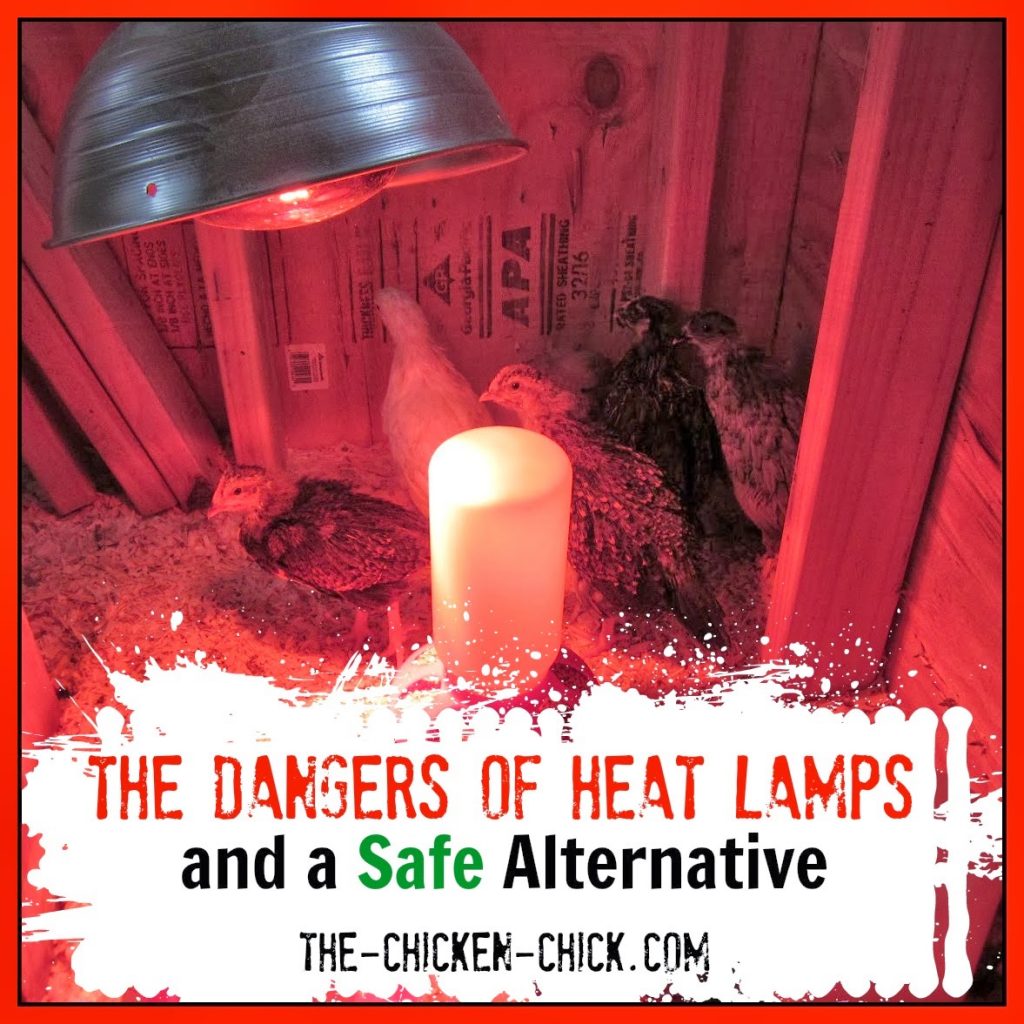

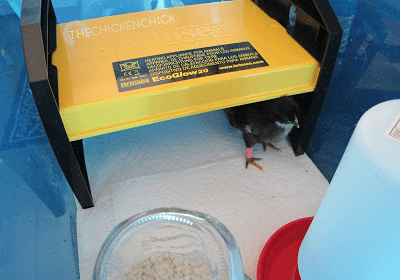




































How can I buy the EcoGlow…
You will find it at this affiliate link: https://amzn.to/3Tcj5gR
I worry about heat lamp in coop, can I use the chicken heating plate for my adult chickens
Adult chickens do NOT require supplemental heat. I explain how to house them safely, comfortably in this article:
https://the-chicken-chick.com/surviving-winter-with-chickens/
Hello, We picked up 6 baby chicks on a Friday had a heat lamp, all the proper feed, water etc bedding…..they were covered and kept warm, and our temps dropped…we covered with a blanket and they had done well…on Sunday am before leaving for church…all 6 were dead all laying apart separate! (sadly) We have called about them…we are all sick now with a flu/resp virus? {any connection}? What could have caused this? They’er replacing them …however? We have raised them before and have a sweet adult group of girls…they were no where near these babies? Your thoughts? Thank you…… Read more »
Chicks must be raised in a room with a temperature NO LOWER THAN 50degrees F.
i cannot afford an eco glow is there a way to keep using the heat lamp
No, not with flying animals. I always recommend waiting until you can care for chicks safely even if that means collecting bottles and cans for a year until you have the extra $30.00 necessary to proceed safely.
I finally got one and I love it. Much simpler to use than the heat lamp I used last time that made me so nervous and was so irritating to hang. The chicks seem to like having a cozy place to hide too. I noticed my chicks last time like to hide in small boxes if one was available. I did notice the plate is more than “barely warm” to the touch. Mine is HOT. is there something wrong with it? I raised it up a bit for fear of chicks getting burned.